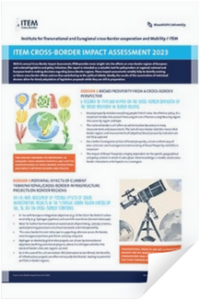As a result of input from ITEM stakeholders, internal discussions and the vision of the ITEM impact assessment working group, the following selection has been made regarding the relevant topics for the 2021 impact assessment. Also this year, ITEM will cooperate with other European cross-border institutes on one particular topic. This concerns the EU draft minimum wage directive and its potential impact on border regions. This video summarizes the 2021 edition of the border impact assessment through video pitches.
Cross-Border Impact Assessment 2021
Files
Ex ante study on the cross- border effects of the EU’s proposed Minimum Wage Directive
This dossier examines the impact of a binding common European framework for adequate minimum wages on cross-border EU regions and their inhabitants.
Read the full dossierImpact analysis into the future of working from home for cross-border workers post-COVID-19
Working from home increasingly became the norm during the COVID-19 pandemic. With working from home being encouraged and in some cases even made mandatory, the huge increase in people working this way is no surprise. According to EU figures, workers worked about 40% of paid hours at home during the pandemic.[1] In the case of the Netherlands, 49% worked wholly or partially at home.[2] Border workers were no exception to this phenomenon. It is expected that workers will continue to work at home to some extent after the crisis, and a large number of them also want to work at home to some extent after COVID.[3] While employers strive to facilitate home working and adjust their policies accordingly, politicians are vividly debating the topic of home working and planning to legislate for it. Several initiatives have been developed to formalize working from home.
Read the full dossierThe effects of national Corona crisis management on cross-border crisis management in the Euregio Meuse-Rhine (follow-up study)
As in 2020, the effects of the coronavirus crisis were again examined as part of the ITEM Border Effects Report. This year, the study focused on the effects of national crisis management on cooperation in the border region in terms of the various local and regional crisis teams. It is still too early to make fundamental statements about the socioeconomic effects in the border region. This became clear in 2020 due to a lack of data.
Read the full dossierIs the EU Patients’ Rights Directive fit for providing well-functioning healthcare in cross-border regions? An ex-post assessment
Although cross-border healthcare is particularly essential for border regions, the differences between member states and especially between their healthcare systems can result in citizens not having access to healthcare or other services in a cross-border setting. In light of the goals of socioeconomic/sustainable development, European integration and Euroregional cohesion, this dossier examines the current challenges of cross-border healthcare and the mismatch of public healthcare systems in the (cross-border) regions of Belgium, Germany and the Netherlands.
Read the full dossier
